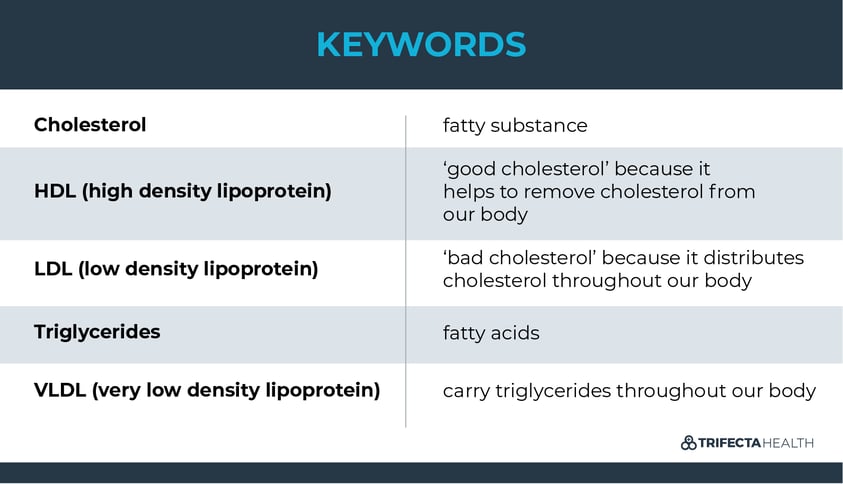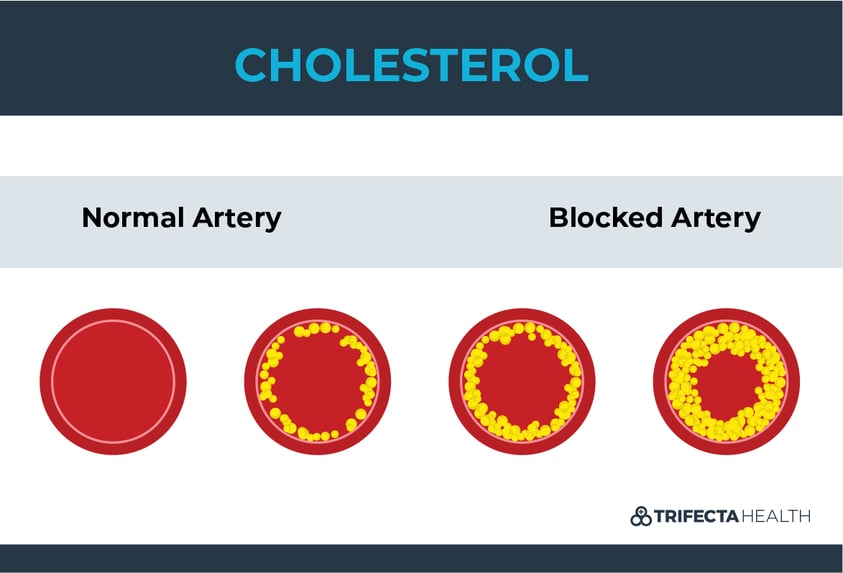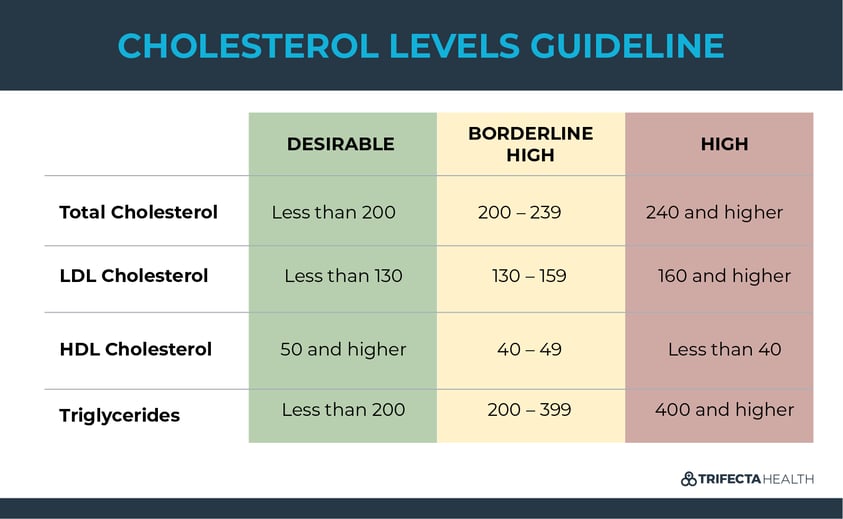Can you picture chunks of fat floating throughout all of your blood vessels? As gross as it may be, this is what having high cholesterol is like - and one out of every three people in the country are affected by this disease (1).
High cholesterol causes all kinds of problems, including heart disease and stroke, which are leading killers in our society today.
Luckily, it's almost always in our power to prevent high cholesterol from developing. And those of us already affected by the disease can lower our levels (and the associated health risks) with the right treatment.
This article explains everything you need to know about high cholesterol, including what it is and 5 ways to lower your cholesterol.
What is Cholesterol?
The definition of cholesterol includes a fatty, waxy lipid that exists in all of our cells. It is essential for our body to build many hormones and other important substances. But we don't need to eat any extra cholesterol to do this because we naturally make all we need.
When there is excessive cholesterol, it forms deposits in our arteries and veins called plaques that can be deadly.
Plaques can clog vessels and block blood flow. This is especially problematic when it happens in our heart (coronary arteries) because it increases the risk of heart attacks and other types of cardiovascular disease. It also poses a major threat to our brains, where plaques increase the risk of stroke (2).
You may hear high cholesterol referred to as hypercholesterolemia, which is the medical term for the disease.
You may have also heard it referred to as 'good' and 'bad' cholesterol or as the acronyms 'HDL' and 'LDL' types. HDL and LDL are actually lipoproteins (substances made of lipids and protein).
HDL and LDL serve as shuttles that are in charge of carrying cholesterol throughout the body. These are referred to as the ‘good’ type and ‘bad’ type of cholesterol.
The Good Cholesterol: HDL Cholesterol
Not all cholesterol is bad. High-density lipoprotein (HDL) is often referred to as ‘good cholesterol’ because its job is to carry cholesterol away from the arteries to the liver. The liver is then able to help remove it from the body.
HDL is so important because it helps to eliminate this waxy substance from the arteries and decreases the risk of vascular disease, stroke, and heart attacks.
Bottom Line: HDL is 'good' because it helps remove cholesterol from your body.
The Bad Cholesterol: LDL Cholesterol
LDL (low-density lipoprotein) has the job of carrying extra cholesterol you eat to your arteries. It is considered to be ‘bad’ because it contributes to clogging our vessels.

Why High Cholesterol is Bad
Blood is rich with oxygen and important nutrients. Your body needs a consistent supply of blood smoothly flowing throughout all of the tissues to continue working normally. It travels through pipe-like vessels to deliver this nutrition to all of the cells in your body.
When people have vessels that are significantly damaged by or clogged with plaque they are said to have atherosclerosis.
Plaques form as deposits in the walls of vessels and cause narrowing of the arteries. This causes disturbances in essential blood flow, and can cause the organs or tissue that the vessel supplies to become damaged.
High cholesterol, high blood pressure, and smoking are the main contributors to atherosclerosis.
Atherosclerosis (aka: vascular disease) can increase the risk of blood clots and is a strong risk factor for heart disease and strokes - both of which are leading causes of death in Americans.
Bottom Line: Too much cholesterol can cause atherosclerosis which can prevent different parts of the body from getting the oxygen and nutrients it needs to survive. When this happens in the brain, it is called a stroke. When it happens in the heart, it is referred to as a heart attack.

Where Does Cholesterol Come From?
Your liver is in charge of making all of the cholesterol you need. Sometimes the liver produces too much. You can get more cholesterol from eating animal products (3).
How is High Cholesterol Diagnosed?
An easy cholesterol test can determine if your blood levels are too high. This is commonly referred to as a lipid profile. The American Heart Association recommends that all adults have their cholesterol numbers tested (4).
Normal Cholesterol Levels
It’s important to know what your cholesterol levels are and what they should be. The goal is for triglyceride and LDL levels to be low, and HDL levels to be high.
Cholesterol Chart

What are Triglycerides?
Triglycerides are frequently measured with cholesterol, but they are composed of a different substance called fatty acids. They are primarily carried by VLDL (very low-density lipoprotein). Similar to LDL, high triglycerides (hypertriglyceridemia) can contribute to clogged arteries.
When people have high levels of LDL, they also often have high triglycerides.
Symptoms of High Cholesterol
A big problem with high cholesterol is you initially can’t tell if you have it - unless you test your blood.
There are often no symptoms of hypercholesterolemia - until you begin suffering from its complications.
High Cholesterol Complications
- Stroke
- Heart Attack
- Other Cardiovascular Disease
- Peripheral Vascular Disease
- Kidney Disease
What Causes High Cholesterol?
Risk factors for high cholesterol and high triglycerides include (5):
- Poor Diet Choices
- Being Overweight or Obese
- Smoking
- Limited Physical Activity
- Family History (familial hypercholesterolemia)
- Age (older)
- Ethnicity
How to Lower Cholesterol
The ideal way to treat high cholesterol is by adopting healthy lifestyle habits. This, alone will often lead to a healthy cholesterol level. However, medications are sometimes also needed to help people who have high serum levels and also in those with an increased risk of stroke and heart disease.
Step 1: Eat a Low Cholesterol Diet.
Among the most important treatments of hyperlipidemia is diet.
1) Choose the Right Animal Products.
Cholesterol comes from animal products. But not all meat contains the same amount of cholesterol.
Lean animal products that are eaten in moderation are frequently included in a very healthy diet. On the contrary, full-fat dairy products, meats high in saturated fat, or cooked in unhealthy oil or fried, and red meat all contain higher levels of cholesterol.
Limiting your red meat consumption and limiting your overall saturated and trans fat intake can significantly lower your cholesterol.
2) Minimize Saturated & Trans Fat.
Saturated fats and trans fats (often called ‘unhealthy fats’) can also actually cause your body to make more cholesterol! Some other foods, like palm oil and coconut oil (often found in baking goods) can also stimulate your body's cholesterol production (3).
These foods are usually unhealthy anyway. They are typically high in calories with low nutritional value. Getting these out of your system will help with both weight loss and minimizing your own cholesterol production.
The American Heart Association recommends only including saturated fat in 5% of everything you eat.
This means making choices like getting rid of fried foods, making low-fat dairy selections, and cooking with small amounts of healthier oils (i.e.: vegetable oils) (6).
3) Increase Your Fiber.
Our bodies love fiber! Increasing your fiber can lower your cholesterol by 10% (7). This also helps bowel health and to prevent diverticulitis.
4) Count Calories.
Weight loss and healthy weight maintenance is critical for getting your cholesterol in check. Learning the number of calories you need to lose weight and keep it off - and then counting those calories is the pathway to weight loss success.
HOw many calories should you be eating in a day?
Step 2: Lose Weight & Maintain a Healthy Weight.
As mentioned above, being overweight or obese is a significant risk factor for high cholesterol. Losing weight requires both calorie control and exercise and can powerfully lower your cholesterol - as well as prevent and improve so many other related diseases like diabetes, hypertension, heart disease, and more.
While calorie control and exercise are the most important steps for weight loss, there are additional dietary considerations you should know if you need to lower your cholesterol.
Step 3: Exercise.
Regular exercise is vital for our well-being. It provides a positive impact on both our mental health as well as many aspects of our physical health. Like many other chronic diseases related to obesity, exercise can improve hyperlipidemia independently by helping the health of vessels and also by contributing to weight loss.
Step 4: Quit Smoking.
Smoking damages vessels and increases the risk of hyperlipidemia. It also contributes to problems for almost every other part of your health. Research shows that the health consequences of smoking are overwhelmingly negative. Just quit smoking.
Step 5: Take Cholesterol Medication as Prescribed By Your Doctor.
Your doctor may put you on medication for cholesterol if your levels are too high. Sometimes doctors also recommend starting medication if your risk of stroke and heart attack are very high (as cholesterol further increases the risk of these conditions). It’s always important to take medication as your doctor prescribes.
But make sure you don’t use medication as a crutch or an excuse. Lifestyle changes are the foundation of getting you back on track and keeping you there!
Bottom Line: The earlier you can integrate healthy lifestyle practices to prevent hyperlipidemia and so many other chronic diseases, the better.


